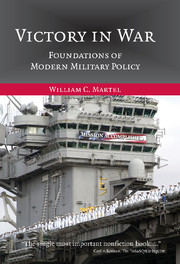Book contents
- Frontmatter
- Contents
- Acknowledgments
- 1 Introduction
- 2 Historical Origins of Victory
- 3 Modern Origins of Victory
- 4 Foundations of Victory
- 5 America's Theory of Victory
- 6 1986 Raid on Libya
- 7 1989 Invasion of Panama
- 8 1991 Persian Gulf War
- 9 Bosnia and Kosovo, 1992–1999
- 10 2001 Invasion of Afghanistan
- 11 2003 Invasion of Iraq
- 12 Military Power and Victory
- 13 Conclusions
- Notes
- Index
10 - 2001 Invasion of Afghanistan
Published online by Cambridge University Press: 05 June 2012
- Frontmatter
- Contents
- Acknowledgments
- 1 Introduction
- 2 Historical Origins of Victory
- 3 Modern Origins of Victory
- 4 Foundations of Victory
- 5 America's Theory of Victory
- 6 1986 Raid on Libya
- 7 1989 Invasion of Panama
- 8 1991 Persian Gulf War
- 9 Bosnia and Kosovo, 1992–1999
- 10 2001 Invasion of Afghanistan
- 11 2003 Invasion of Iraq
- 12 Military Power and Victory
- 13 Conclusions
- Notes
- Index
Summary
On September 11, 2001, four airplanes were hijacked by al-Qaeda operatives, who deliberately flew two aircraft into the World Trade Center towers in New York City and one, about half an hour later, into the Pentagon in Washington, D.C. The fourth plane crashed into a field in Pennsylvania, short of its intended targets in Washington, which are believed to have been the Capitol or the White House. Since some attacks were directed against the political leadership in Washington, many senior officials in the U.S. government believed that al-Qaeda had planned to decapitate the government by destroying the Pentagon and the White House or Capitol, thereby killing its most senior officials. Those attacks – the first on American soil since the raid against Pearl Harbor on December 7, 1941 – killed nearly three thousand people.
While the American people and their leaders still reeled from the enormity of the terrorist actions and mourned their dead, the political and military leadership in the administration of President George W. Bush had already begun planning to launch a counterstrike against al-Qaeda's leaders, who operated with impunity in Afghanistan under the protection of the repressive Taliban regime. In an event that marked a historic change in the nature and conduct of American foreign policy, on October 7, 2001, just three and a half weeks after the attacks on Washington and New York, President Bush ordered the invasion of Afghanistan in what was called Operation Enduring Freedom. The invasion began with an air campaign to attack facilities used by al-Qaeda to train its cadres of terrorists.
- Type
- Chapter
- Information
- Victory in WarFoundations of Modern Military Policy, pp. 223 - 242Publisher: Cambridge University PressPrint publication year: 2006



